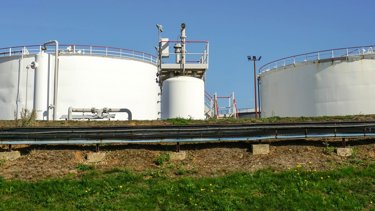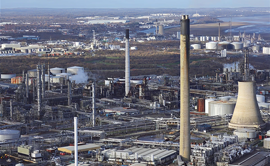An overview of non-destructive testing (NDT) for above-ground storage tanks
Updated: 7 March 2023
Published: 22 February 2023
What is non-destructive testing (NDT)?
Non-destructive testing (NDT), also known as non-destructive examination (NDE) or non-destructive inspection (NDI), is a set of techniques used to evaluate materials without causing damage to them.
This process involves inspecting, testing, or evaluating materials of components or assemblies for discontinuities or differences in characteristics without destroying the serviceability of the part or system. In other words, when the inspection or test is completed, the part can still be used.
Non-destructive testing is a common practice in fuel storage to detect and assess potential problems like corrosion, stress, cracking and pitting in fuel tanks and pipework. By recognising potential issues, it is possible to take preventive action or replace the tank before any spills or leaks occur.
The goal of non-destructive testing is to ensure that critical infrastructure is properly maintained in order to avoid catastrophic accidents.
Early adoption of good non-destructive testing procedures saves time, money and reputation
Non-destructive testing is a cost-efficient and reliable method of performing essential inspections of your fuel systems without causing any harm or destruction. This prevents your assets from being damaged in the process of inspection and provides peace of mind that the risk of any contaminants to the environment has been minimised.
Implementing a detailed non-destructive testing process can help you to:
- Reduce downtime of your operations while keeping you compliant
- Remain compliant with EEMUA 159 and API 653 guidance
- Lower maintenance costs in the longer term
- Adopt best working practises with safety as top priority
As soon as a storage tank is built and installed, a comprehensive maintenance cycle should start. This consists of regular visual inspections, and implementing planned preventive maintenance to keep the tank and containment to the required condition.
Based on these inspections and established non-destructive testing results, calculations are made for the remaining lifetime of your storage tank. By implementing the correct maintenance and inspection regimes, the lifecycle of your tank can potentially be prolonged.
Convenient, accurate and sustainable
Non-destructive testing can detect flaws and differences in materials that negate the need to employ destructive methods. This makes testing of fuel storage tanks convenient, accurate and sustainable - elements that other methods of testing don’t offer.
Non-destructive testing can aid in the early detection of stress points and wear and tear before failure happens, prolonging the lifespan of your resources. This significantly lowers the likelihood of interruptions due to problems with storage tanks.
Carrying out non-destructive testing on your storage tanks can provide trend-based information on deterioration, helping to predict where the worst issues might be found and successfully prevent a pollution incident.
Complying with EEMUA 159 and API 653
Staying compliant and following regulations is essential. A planned non-destructive testing schedule can prove compliance with the guidance established in EEMUA 159 and API 653 standards.
The guidance in EEMUA 159 and API 653 covers above-ground, flat-bottomed storage tanks and details the inspection, maintenance, and repair of these storage tanks. It offers guidance on the inspection and maintenance of tanks built to BS, EN or API standards for the storage of petroleum.
These world-renowned standards define the best engineering practices for safe and effective tank storage operations. Following them and implementing their suggested strategies can give you peace of mind that your fuel storage tank and infrastructure is in sound operational condition.
Various methods of non-destructive inspection can be used without causing disruption, allowing businesses to keep their vital infrastructure functioning without interruption.
The Health and Safety Executive (HSE) recommends that non-destructive testing on fuel storage tanks is carried out at least every 10 years, depending on the last inspection or inspection report, or when the tanks were built.
External inspections
API 653
All tanks shall be given a visual external inspection by an authorised inspector. This inspection shall be called the external inspection and must be conducted at least every 5 years, or the quarter corrosion rate life of the shell. Tanks may be in operation during this inspection.
EEMUA 159
According to table B.3, external inspections range from 1-year to 15-year intervals.
Factors include climate and type of product stored in the tanks. For example:
- Crude oil and refined products with no internal liner - 5 years
- Finished products with internal liner - 8 years
- Jet A with internal liner - 10 years
Internal inspections
API 653
Based on the bottom corrosion rate, not to exceed 20 years.
EEMUA 159
According to table B.3, internal inspections range from 3-year to 20-year intervals.
Factors include climate and type of product.

Different methods of non-destructive testing for different materials
Each method of non-destructive testing uses a different technique to examine the subject material.
Visual testing
Visual testing is a widely-used form of non-destructive testing that involves examining a specimen to see if any issues are visible without needing to cause damage. This is a great way of spotting corrosion, cracks, welding defects, deformation, and more.
In cases where it is not possible for an inspector to access hazardous or hard-to-reach areas, drones are often employed instead.
Ultrasonic testing (UT)
Ultrasonic testing is a technique used to examine the internal structure of materials by sending high-frequency sound waves through the material in order to measure the reflected response. It covers a wide range of frequencies, usually between 500 KHz and 50 MHz. This method can be used to discover characteristics of the material such as its thickness, density, and composition, as well as any flaws, cracks, or other defects.
There are different types of ultrasonic testing, such as pulse-echo testing, immersion testing, guided wave testing, and phased array ultrasonic testing.
Magnetic flux leakage (MFL)
Magnetic flux leakage is a magnetic method of non-destructive testing that is used to detect corrosion, pitting and wall loss in steel structures. It is commonly used for inspecting storage tank floors in the petrochemical industry, but can also be used on pipeline inspections.
This approach involves utilising a strong magnet to generate a magnetic field that saturates metal structures like storage tanks and pipelines. Sensors are then used to identify magnetic flux leakage, which could be a sign of wear caused by pitting, erosion, or corrosion.
Liquid penetrant testing (PT)
Liquid penetrant testing is designed to detect any surface-level flaws. The process involves applying a low-viscosity liquid to the area in question and wiping away any excess. After a period of time, a special developer is applied that allows the penetrant to be drawn up to the surface. The specimen is then left to sit for a predetermined amount of time to allow the developer to take effect.
A visual check can be done to see if the dye is present. For fluorescent dyes, ultraviolet light is necessary to detect it.
Magnetic particle testing (MT)
Magnetic particle testing utilises magnetic fields to detect imperfections close to the surface of ferromagnetic materials. These fields can be generated either with permanent magnet or by running an electric current through an electromagnet.
Any cracks in the object being examined are made visible by the leakage of the magnetic flux lines, and this can be detected by using magnetic particles that are drawn to the surface.
Electromagnetic testing (ET)
Electromagnetic testing (eddy current testing) is carried out using a specially designed coil that is energised with an alternating current that creates a changing magnetic field surrounding the coil. The coil is placed within the proximity of a test surface, where the changing magnetic field permeates the conductive material.
Eddy current testing can used for crack detection on coated welds and determining the thickness of non-conductive coatings.
Our team are ready to help
Non-destructive testing is a widely-used, beneficial method for businesses to assess the characteristics of items, components, constructions, or systems without doing any harm. There are several types of NDT available depending on the scenario.
The advantages of non-destructive testing in terms of efficiency, cost-effectiveness, and safety are causing it to become the preferred choice for uncovering flaws in fuel storage and infrastructure.
With inspectors certified to EEMUA 159 and API 653 standards, our specialist tank integrity inspection team are able to provide non-destructive testing services for your storage tanks - speak to us today.
More from our Knowledge Hub
 White paper
White paperDelivering Section 82: A whole-sector response to continuous water quality monitoring
 News
NewsCelebrating our Rising Star: Jack Anderson
 News
NewsSetting the standard: Adler & Allan celebrates triple success at UK & Ireland Spill Association Annual Awards 2025
 Webinar
WebinarClimate Resilience: Protecting Your Assets and Operations
Environmental compliance today, creating a sustainable tomorrow
Helping you reduce risk to the environment and your operation by managing assets compliantly while achieving commercial, ESG, and net-zero goals.
Contact our experts
